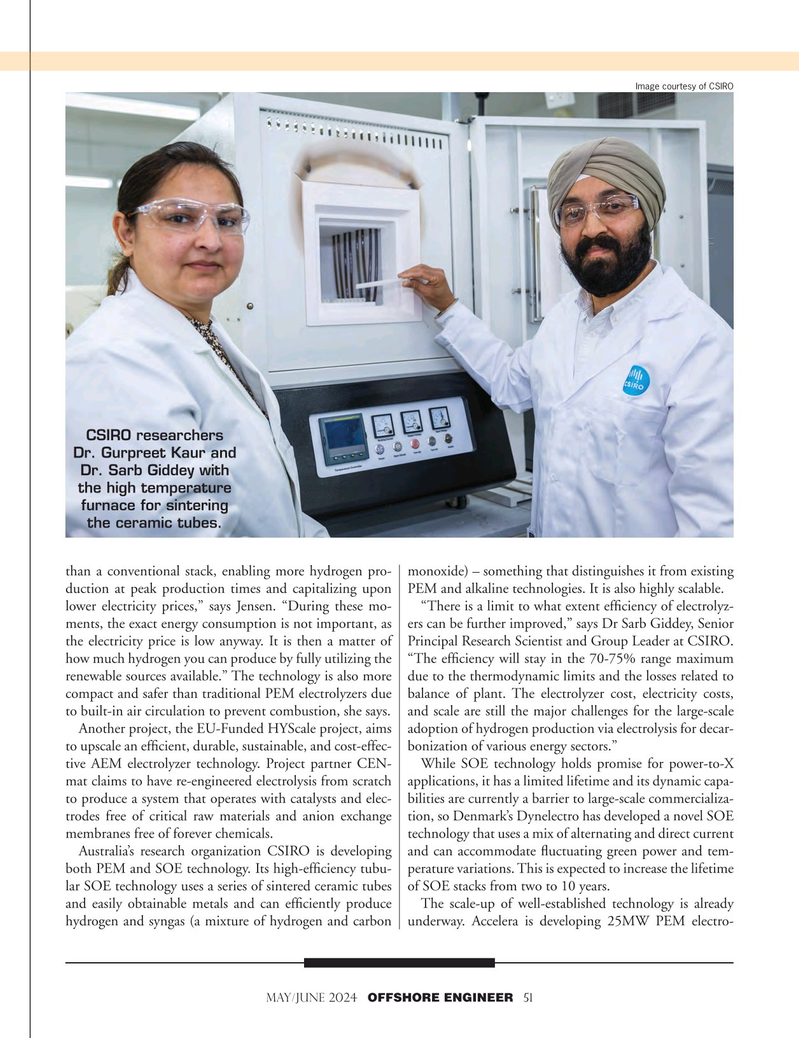
Page 51: of Offshore Engineer Magazine (May/Jun 2024)
Read this page in Pdf, Flash or Html5 edition of May/Jun 2024 Offshore Engineer Magazine
Image courtesy of CSIRO
CSIRO researchers
Dr. Gurpreet Kaur and
Dr. Sarb Giddey with the high temperature furnace for sintering the ceramic tubes. than a conventional stack, enabling more hydrogen pro- monoxide) – something that distinguishes it from existing duction at peak production times and capitalizing upon PEM and alkaline technologies. It is also highly scalable.
lower electricity prices,” says Jensen. “During these mo- “There is a limit to what extent effciency of electrolyz- ments, the exact energy consumption is not important, as ers can be further improved,” says Dr Sarb Giddey, Senior the electricity price is low anyway. It is then a matter of Principal Research Scientist and Group Leader at CSIRO. how much hydrogen you can produce by fully utilizing the “The effciency will stay in the 70-75% range maximum renewable sources available.” The technology is also more due to the thermodynamic limits and the losses related to compact and safer than traditional PEM electrolyzers due balance of plant. The electrolyzer cost, electricity costs, to built-in air circulation to prevent combustion, she says. and scale are still the major challenges for the large-scale
Another project, the EU-Funded HYScale project, aims adoption of hydrogen production via electrolysis for decar- to upscale an effcient, durable, sustainable, and cost-effec- bonization of various energy sectors.” tive AEM electrolyzer technology. Project partner CEN- While SOE technology holds promise for power-to-X mat claims to have re-engineered electrolysis from scratch applications, it has a limited lifetime and its dynamic capa- to produce a system that operates with catalysts and elec- bilities are currently a barrier to large-scale commercializa- trodes free of critical raw materials and anion exchange tion, so Denmark’s Dynelectro has developed a novel SOE membranes free of forever chemicals. technology that uses a mix of alternating and direct current
Australia’s research organization CSIRO is developing and can accommodate fuctuating green power and tem- both PEM and SOE technology. Its high-effciency tubu- perature variations. This is expected to increase the lifetime lar SOE technology uses a series of sintered ceramic tubes of SOE stacks from two to 10 years.
and easily obtainable metals and can effciently produce The scale-up of well-established technology is already hydrogen and syngas (a mixture of hydrogen and carbon underway. Accelera is developing 25MW PEM electro-
MAy/june 2024 OFFSHORE ENGINEER 51

 50
50

 52
52